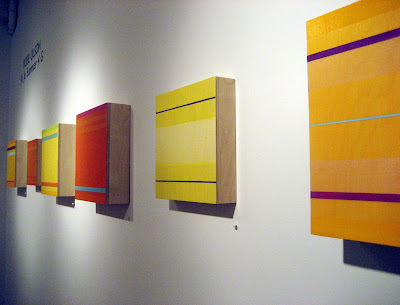.
I have a dealer friend who forwards me some of the artists' e-mail inquiries she receives. She does this partly, I think, because she has to share them with someone (you can't make this stuff up), and partly because she knew that eventually they would make their way into a Marketing Mondays post as a cautionary tale.
 The dealer deletes all the names, so all I'm seeing is the message. Unfamiliarity with the submission process is painfully evident in these letters, but also it seems that fear (and in one instance, arrogance) got in the way of basic communication. I don't think any dealer is expecting a formal missive, but a short paragraph with a few informative sentences is not an unreasonable expectation. Take a look at five queries that didn't have what it takes:
The dealer deletes all the names, so all I'm seeing is the message. Unfamiliarity with the submission process is painfully evident in these letters, but also it seems that fear (and in one instance, arrogance) got in the way of basic communication. I don't think any dealer is expecting a formal missive, but a short paragraph with a few informative sentences is not an unreasonable expectation. Take a look at five queries that didn't have what it takes:
1) Hello there,
My boyfriend and I are looking to submit artwork (acrylic paintings) and wanted to know if you would be able to provide us with the fees, how long it can be displayed for, insurance, what percent the gallery takes when a piece is sold, rules and regulations ... etc ... of having our art in your gallery, after being reviewed and accepted of course.
Thank you for your time!
Sincerely,
Artist Name and Boyfriend Name w/ URLs
. The dealer was not addressed personally
. The artist included no description of the work and no j-pegs
. The artist did not look at the submission information online
. Says the dealer: "The artist is so clearly inexperienced that I wouldn't consider talking to her because of the work it would take to educate her, or any artist, at this point in their career"
2) Dealer name,
Thanks for the invite, but I'll pass. You actually call this stuff art? You must be desperate to find real talent. By the way, I'm available.
Artist Name
. While the artist did provide a link to his work, no dealer wants to work with a pompous A-hole. Here's what the dealer said: "Who asked for his opinion? The email invite wasn't a request for criticism, it was an invitation. Do I go to his website and say, 'Hey, your art sucks'?"
3) No salutation
I would like to introduce you to my latest work. I paint the colorful souls of dogs! Here's a link to my website. Browse to your hearts content and let me know if you are interested in these joyful spirits captured on canvas. I am currently represented in [artist names five cities]. I am interested in having a gallery in [your city] and this is why I thought of you.
Artist Name
. Not your gallery specifically, just a gallery in your city, any gallery; that makes a dealer feel special. Woof
4) Dear Dealer name,
Attached please find 4 pages of black and white drawings, CV and artist statement. Thank you and I look forward to hearing from you.
Sincerely,
Artist Name
. This artist was trying to keep it professional in this physical package, but s/he made the query too short. Say something about your work in less formal terms than an artist statement, at least so the dealer knows you have something to say about it, and at best so that you pique the dealer's interest
. Why was s/he contacting that particular gallery? Dealers like to know you’re familiar with the program, ideally that you've visited the gallery.
.5) Greetings.
No, you don’t know me and yes, I’m a painter. Painting is a joy, a real great vocation and, certainly, a tough way to try to make a living. Yes; I live off it, not a great life but a decorous one. I manage to sell my work every now and then and I’ve even been selling some in the internet. Still, just enough. I write this letter on the very simple assumption that as a professional in the world of art you just might be interested in knowing some different way of painting. I don’t want to burden you with my own opinion of my art work or a bunch of resume data so, how about visiting my site? It won’t cost you, hopefully it won’t bore you and, of course, you are free to log off any time you feel like it. Maybe then you can let me know your opinion and, who knows, perhaps establish a working relationship.
Regards,
Artist Name
. Too much non-useful information, the opposite of #4
. Give the dealers something to make them look!
. It really does help when the dealer knows, or is at least familiar with, the artist. This is why it's so important to visit the gallery regularly and to be familiar with the dealer's program
My point in sharing these e-mails is simply to remind artists to do their homework in selecting galleries to target. When you write, keep it short, informative and professional. Remind yourself that you're writing to another human being with a very busy workday and a huge overhead, not some all-powerful being who is the one and only entity in the universe to hold the keys to your successful future. Include basic information--describe the work with a phrase about it or about why you're involved with that particular theme--and, ideally, an embedded picture (along with a couple of Jpegs). Then if you get turned down, it will be because the work didn't resonate for the dealer, not because you sounded like an idiot. I don't mean you personally, of course.

































































